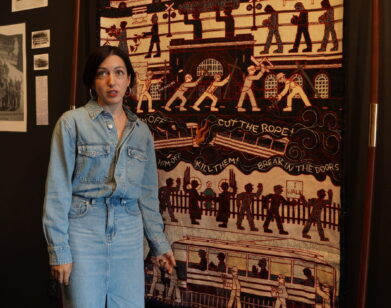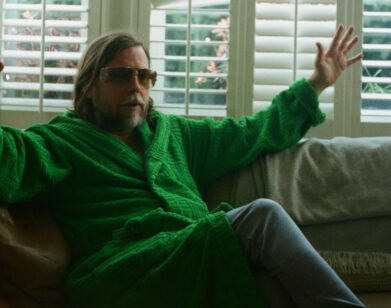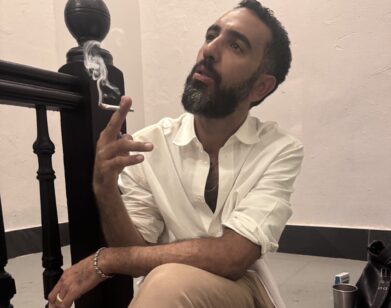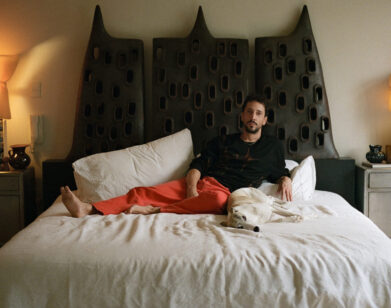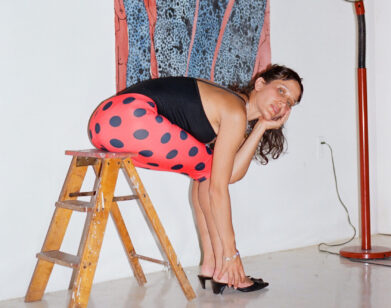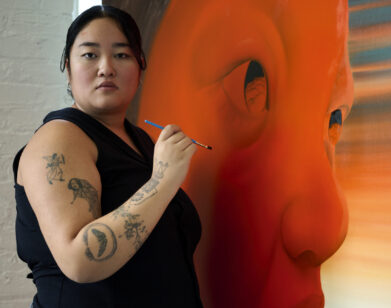Artists at Work: Maya Lin
MAYA LIN IN NEW YORK, JULY 2017. PHOTOS: VICTORIA STEVENS.
This summer, during group shows and ahead of fall exhibition openings, we’re visiting New York-based artists in their studios.
At 21, while studying at Yale University, Maya Lin was chosen to design the Vietnam Veterans Memorial. It’s a credit that’s followed—rather, chased the artist since 1981. Now, at 57, it’s a matter of fact to say it’s only one small facet of an ever-expanding practice, which includes installations, architecture, an interactive website, a nonprofit organization, earthworks and sculptures (both of which she considers three-dimensional drawings), and, yes, more memorials.
Lin splits her time between New York City and Ridgway, Colorado; it’s a choice that’s emblematic of her artistic approach, which is a system of binaries: research and creation, machine-made and handmade, public and private. Currently, she’s working on multiple architecture projects—such as the design of an East Coast university’s arts complex—and thinking about water. Her obsession with that element will take form in “Maya Lin: Ebb and Flow,” an exhibition opening this September at New York’s Pace Gallery. She’ll trace bodies of water by mapping them on walls; she once constructed the Chesapeake Bay with light green glass marbles in Folding the Chesapeake (2015), and this time she’ll depict the Nile and Lake Victoria. Other works will re-visualize Antarctica and the collapse of its ice. Environmentalism is a central to Lin’s practice; one of her dreams is to transform a landfill into a non-toxic earthwork, and in her free time she sifts through climate change data and buys atlases at the Strand, which she sometimes carves into with a knife, tracing natural borders and building her own topography.
Interview recently caught up with Lin at her downtown Manhattan studio.
MAYA LIN: I’ve always been pretty fixated on water. Maybe it’s because it exists in multiple states, and you can never understand it in nature as a fixed moment in time. The new show coming up at Pace is called “Ebb and Flow,” and it’s also about that. At one point I said, “Can we stop time? Can we freeze a moment in something that is always in flux?” For some odd reason, I’m very interested in the shifting flux of things.
HALEY WEISS: Can you trace your interest in water to a specific body of water from your youth? Or is it more of an intellectual interest?
LIN: I think it actually started where I grew up; it was like a Hansel and Gretel cottage, this strange little house that some builder built. It was in an area where there were three ridges, and there were streams coming down, and this house was kind of caught [in the middle]. Our playground was the woods surrounding the house. Every time it rained, all this water would be coming through, and we’d be damming and undamming. I was out in the crick—the creek, it’s the Appalachian [pronunciation].
I just went home to Athens, [Ohio,] and I think as a kid I was desperate to get out of there. Now I go back and it’s like, “Oh my god, it’s so beautiful.” It’s southeastern Ohio, so it’s very hilly, and I would spend my days outside. My backyard was all woods and streams and nature, and I think that thoroughly grounded me, as well as coming of age during the Clean Air Act, the Clean Water Act, the Endangered Species Act. I would say in the ’70s, there was Civil Rights, there was the Vietnam anti-war movement, there was women’s rights, but then it was the environment. I was actually going to become a field zoologist. I’ve always loved animals, and I got to Yale thinking that would be my path. I kind of was a polyglot as well; I liked art, I liked science, and I liked English, almost equally, but my love and care about the environment started because of the ’70s environmental movement. Lake Erie catches fire, you have incredible pollution in waterways, endangered species—we were really becoming aware of what’s going on. It’s always been a part of every thing I do. You can even trace it back to the Vietnam Memorial; I saw it as a park, and I wanted to insert something that would be there but still allow you to appreciate and understand the park. I wanted to go into the site and create what I would call an intervention, that when it’s done almost merges and will become ambiguous, say 300, 400 years from now—like the Serpent Mound, like a lot of the ancient burial mounds, again in southeastern Ohio, they’re in farmer’s cornfields. You know they’re there, but can you tell if it was manmade or if it was natural? It’s that strange ambiguity. My guess is that [my interest in] that ambiguity is maybe because my parents immigrate—flee from China—and they were always questioning where home was. So this constant status of flux is not so much a material interest in water, but a cultural divide to anyone who comes from another country and actually had to leave that country in a hurry, with absolutely nothing, and make a new home. You’re always feeling like, well, where is home? That definitely plays into a lot of this—that divide.
WEISS: In the past you’ve said that one of your interests is revealing what seems invisible or is invisible. Would you say that’s still true?
LIN: Absolutely. [That’s true of this recent,] unusual piece, which is between an oyster shell and what I call an imaginary iceberg. I literally just came back from Spain because we cut it. It’s about eight feet long, it’s going into a private collection, and the Larsen C Ice Shelf just broke off. Normally an iceberg, you only see the top 10 percent. Everything is underwater, and you actually never know what it is, because even if you could scan it in an instant, the next instant the wave action is going to melt it a different way. Icebergs are another thing that I’m really interested in, and aquifers, which again, it’s very, very hard to understand what they are. We know under Nebraska there is an underground aquifer that is probably underneath the whole state, but what form does it take? I kind of want to focus on that, for almost political means, because we keep digging more wells. We’re not replenishing, and we’re having a crisis in water around the world. But how do you visualize it? I don’t know, so I know what I want to study.
WEISS: That’s interesting because the climate change debate seems to rely so much on the ability to visualize data, like when a piece of ice breaks off it’s described as “the size of Delaware.”
LIN: Right. So now, because of what just happened with the Larsen C, part of the summer is not just look at the rivers, but I really want to understand this [data visualization problem]. First I want to understand it for me, and then I want to play with ideas. Because I think it is very hard, and as an artist, you have to be extremely careful that it does not end up becoming a science exhibit; that’s a weird balance that you have to mediate between. That’s where the process ends up getting translated into drawings and sketches, and what comes out is much more, in a way, handmade and crafted rather than just scientific. But then you turn it back with this very high-tech way of [physically making] it.
We couldn’t have looked at the world this way even 20 years ago. I always say I’m no different than a 19th-century landscape painter, it’s just that we have these incredible tools to look at the Earth and look at the world around us differently. [gestures to the table full of papers in front of her featuring climate change data] These are all of the things that I’ll be taking out to Colorado with me. The Ross [Ice Shelf] was the first one to go, and the issue was that scientists tend to be extremely cautious, and they thought, “Oh, it’s going to take years.” I think the Ross swiss-cheesed out and went in a matter of months, and that’s what people don’t realize, it’s not just the overall footprint that’s diminishing, it’s the thickness. And the thinner it gets, the more vulnerable it is to wave action from underneath. So again, we don’t see it, we don’t get it.
WEISS: So, you’re like a landscape painter with a lot more information, but your motivations are also different. You do have an activist stance, at least in the use of the data.
LIN: I think I’ve always had an activist stance, yet at the same time, the other side of me—and this is where some people just don’t get it, or they’d prefer it if the work was a lot uglier, a lot louder—I have this personality where I just want to put something out that’s a fact and then let you interpret it. It’s almost as if you might barely notice it, you might walk right by it, but you have to pay attention. I would say that [it goes back to] my parents. They let us do whatever we wanted to do—a very unusual upbringing—and my mother was a writer and a poet, and my dad a dean of fine artists and a ceramicist. They had been brought up much more strict, and they didn’t want their kids to be fettered by that, so there was a real love for creativity. In that sense, I can’t shout out, “Do this.” I don’t want to be prescriptive. I want to give you facts, and that’s the way I’ve always operated, whether it’s a historical fact or a scientific fact, and then you actually have to connect it in your brain.
There is a very huge part of the [What Is Missing?] foundation’s work with the website that is prescriptive; it’s what you can do in greenprint, but greenprint gets me back to what I do as an artist, which is, I’m going to get you to rethink what the problem is. I always give the analogy of the Earth at Night picture, of 7.3 billion of us, right? And everyone says, “Well, that’s population.” Well, if you took the entire world’s population and you lived at the density of Manhattan proper—not a bad place to live—how much space do 7.3 billion people take up? The state of Colorado. At which point I end my lectures, because I want you to be thinking … is this really a question of population, or is this a question of land use and resource consumption? And let’s face it, the top 1.3 billion of us are doing all the damage. Sorry. [laughs]
WEISS: No, don’t apologize.
LIN: I apologize, because it’s not in my nature. Missing is very activist-oriented, subtle compared to others, but at the same time, it puts me in an uncomfortable place, because I always want to be a little bit more, “Just put it out there.” Obviously every time you point someone in a certain direction you’re being political, but it’s just the facts, I’m not telling you, I’m focusing you. With Missing, I’ve always cared about the environment, so it’s given my background, given where I’m coming from and some of my earlier works, what can I do to help?
WEISS: How does the architecture work play into all of this?
LIN: The data analysis. I do think the smaller-scale studio works have that incredible love of data crunching, whereas I would say the large-scale earthworks tend to be much more stripped-down. With the mappings, as connected as they are to a much more analytical idea, what’s a map? And can I make a map about time? I think the first time was Hurricane Sandy, the flood plane; a moment in time, but indelibly marked on any of us who were in the city. Mapping time is something that I’m really interested in.
WEISS: You mentioned that when you were first going to Yale, you thought you might be a field zoologist. You were sort of thrust into being an artist—
LIN: No, I went to architecture school because I got labeled as an architect. The architecture professors were having a horror of time because I kept spending more and more time over in the sculpture department, and I don’t tend to think analytically as an architect. I analyze more like a scientist; I’m exploring the Earth, but not necessarily finding meaning and symbolism. Whereas I think with architecture, you get to codify, you understand why you do what you do. In a way, I’m much more interested in that I have no idea what it is or where it will lead to. So I got labeled as an architect, and in a weird way, on top of that, I got labeled as “the girl that,” “the kid that” [made the Vietnam Veterans Memorial]. It wasn’t until I built the Wexner Center of the Arts Groundswell, with 40 tons of broken glass—before, wherever I went somewhere it would be, “I love the Vietnam memorial,” and, “That’s great, but I’m kind of doing other stuff”—and then someone came up to me, and I’ll never forget it, they said, “I really love Groundswell.” It took me 15 years. You could’ve come out of art school, this is my awareness, and been called an artist; all my friends were coming to New York right after we all graduated, they were all artists. And I remember being at the table with a couple of art professors, and they said, “Well, your work isn’t art. You’re a memorialist.” And I went, “Hmm.”
WEISS: You’d made a memorial.
LIN: I’d made a memorial. I’ve made a few others, but! [laughs] What it did was, I just kept pursuing what I do. I don’t think I ever really understood why; I just was very curious.
WEISS: I’d be curious to hear what you think about that first public work now.
LIN: I can appreciate it. I’ve always appreciated it. I think I needed to really move past it, and be equally balanced. It’s a bit unusual, as you said, to be working between the architecture, the art, and what I would say is a synthesis, the memorials—they’re problem solving, but it’s very symbolic. You get this triangle; I need to be balanced with those three. They’re all equally a part of who I am. I love how different they are, and yet they’re coming out the same thing, whatever it is.
“MAYA LIN: EBB AND FLOW” WILL BE ON VIEW AT PACE GALLERY IN NEW YORK FROM SEPTEMBER 8 THROUGH OCTOBER 7, 2017. FOR MORE ON MAYA LIN, VISIT HER WEBSITE.


